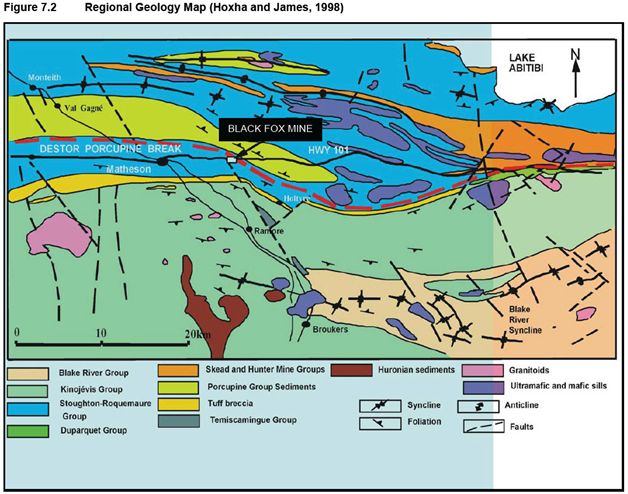Primero Mining Corp.
Black Fox Cpmplex

The Black Fox mine is located near Timmins, Ontario and is hosted on a land package of 18 square kilometres, known as the Black Fox Complex. Both the open pit and the underground mine are in commercial production starting respectively in May 2009 and October 2011. Primero acquired the Black Fox Complex in March 2014.
The Black Fox deposit (formerly the Glimmer Mine) is located approximately 10 km east of the town of Matheson, Ontario, 65 km east of Timmins, along Hwy 101 east and approximately 655 km north of Toronto, in northeastern Ontario, along the Destor Porcupine Fault Zone (“DPFZ”). The DPFZ has a strike length of about 200 km, and many of Ontario’s richest gold mines are located on or near the DPFZ.
The property includes approximately 1,761.41 hectares (ha) of land. Much of the old mine infrastructure at the Black Fox complex was upgraded in 2010 to facilitate mine development. New infrastructure to support open pit and underground mine operations include a truck shop, laboratory, administration building, the firewater/ freshwater pump house, and ancillary buildings.
The Black Fox mill is located 28km away from the Black Fox mine. The mill is fed from an existing 27 kilovolt (kV) power line to the mill site. Power is distributed at the plant site from this 27 kV power line, a 5 mega volt ampere (MVA), 4,160 volt (V), 3 phase, 60 hertz (Hz) distribution transformer. Fresh water at the Black Fox Complex is being supplied from a fresh water well. Water from dewatering of the complex is channelled to the mine's holding pond for recycling and /or discharge through the Black Fox water treatment facility. Excess water is treated during the spring and summer months for discharge to the environment through the water treatment system.
Supplies and services are available in Matheson or Timmins and can be delivered with a 12-hour turnaround. The primary industries are forestry and mining, and Black Fox is located in a well-established mining camp. Because of this, mining and exploration personnel as well as equipment can be found locally for projects in the area.
Temperature ranges from 20 degrees Celsius (°C) to 33°C during the summer months and -30°C to 10°C during the cooler winter months of October to May. The average precipitation is 873.4 millimetres (mm) per year and ranges between 44.5 mm in February to 100.1 mm in July.
HISTORY
The Black Fox Complex was first explored by Dominion Gulf in 1952 and then by Hollinger in 1962. In 1988, Glimmer Mine Inc. put together the property package using a combination of crown (i.e. lands owned by the Canadian government) and private lands. In 1989, Noranda Exploration Company Ltd. ("Noranda") entered into a joint venture agreement with Glimmer. As a result of this agreement, Noranda held a 60% interest in the property. During their ownership, Noranda merged with Hemlo Gold Mines Inc. ("Hemlo"). Exall purchased the property from Hemlo in April 1996, obtaining an approximately 60% interest in the property with Glimmer retaining 40%.
In September 2002, Brigus Gold purchased all of the real estate and related assets of the mine, which ceased operations in May 2001, from Exall and Glimmer Resource Inc. ("Glimmer") and renamed it "Black Fox".
In July 2008, Brigus Gold completed the acquisition from St. Andrew Goldfields Ltd (“St. Andrews”) of the former Stock mine and mill and related equipment, infrastructure, property rights, laboratory and tailings facilities, located near Timmins, Ontario . On November 6, 2007, Brigus leased from the Frederick William Schumacher estate the surface and mining rights to lease parcels 16262, 16265 and 16266, all in the township of Hislop. The properties were renamed Grey Fox.
In September 2009, Brigus completed the acquisition of the Pike River property, contiguous to the southeast boundary of the Black Fox mine and the northwest boundary of the Grey Fox property. The Pike River property was acquired from Newmont Canada Corporation ("Newmont").
Primero acquired Brigus Gold in March 2014.
Geology and Mineralization
Geology and Mineralization
The Black Fox mineralization is an Archean age, lode gold deposit located within the Abitibi greenstone belt. The characteristics of this deposit type include; greenstone host rocks and gold-bearing quartz-carbonate veins. The veins occur as two main types. The first are arrays and stockworks along faults and shear-zones with a quartz-carbonate laminated fault-fill. The second are widely distributed extensional veins within carbonatized metamorphosed greenstone rocks. These deposits are typically associated with crustal scale compressional faults with a vertical extent of ≤2 km and limited metallic zoning (Dubé and Geosselin, 2007).
The Black Fox deposit lies along the DPFZ, a major, east-west trending, deepseated, crustal fault zone. The DPFZ and its numerous splays are associated with many past and current producing gold mines and gold deposits in the Porcupine Camp. The Stock and Aquarius gold deposits are located immediately west of Black Fox and the Holloway and Holt-McDermott Mines are located immediately to the east. Each of these deposits hosts approximately 800 k to 1 million oz gold. The Black Fox deposit is situated midway between two major mines, the Dome-Hoyle Pond and the Holt-Holloway. The Dome-Hoyle Pond deposits located within the same structural regime 65 km west, have shown that gold bearing structures can be traced to 1,600 m below surface where they remain open at depth. The Holt- Holloway Mine, located approximately 45 km to the east has been developed down to 1,200 m below surface.
There are several different styles of mineralization in the deposits associated with the DPFZ. The gold mineralization is structurally controlled, in a variety of geological settings. Alteration types include pyritic ankerite-sericite ± silica-albite altered mafic volcanics, green carbonate fuchsitic altered ultramafic volcanics with quartz stockworks, pyritic, porphyritic to syenitic felsic intrusives and multiple stages of quartz veins with free gold. Much of this variation is found at Black Fox.
The attached figure illustrates the regional geology of the area.
Gold mineralization at Black Fox occurs mainly within an ankerite alteration zone 1 km along strike and 20 m to 100 m wide. This alteration envelope occurs primarily within komatiitic ultramafics and lesser mafic volcanics within the outer boundaries of the DPFZ. In some areas, the auriferous zones are concordant, which follow lithological contacts and have been subsequently deformed to slightly discordant zones that are associated with syenitic sills. Other auriferous zones occur in quartz veins and stockworks discordant to lithology.
The three main styles of gold mineralization observed at Black Fox are:
• Low-sulfide mineralization associated with abundant quartz veining and quartz stockwork within strong ankerite-fuchsite altered ultramafic volcanic rocks.
• Mineralization hosted within mafic volcanic units associated with >5% pyrite and minor to moderate quartz veining.
• Mineralization hosted by silicified felsic dikes.
Mining and Processing
Mining and Processing
Open pit and underground mining operations are currently used at the Black Fox mine. The open pit mine and the Black Fox mill have been in operation since May 2009, and commercial production from the underground mine commenced in October 2011.
Underground mining as expected reached the production rate of 1,000 TPD by the end of 2014. Mining of underground ore is performed using all company owned equipment and employees.
Underground ore is produced using long hole, cut and fill, and narrow vein mining methods. The ore is accessed from a series of declines off of the main ramp to surface. The underground portion of the Black Fox mine is expected to extend from below the existing open pit mine (near 200 m depth below surface) to more than 800 m in depth below surface.
Current backfill is a combination of mine waste rock mixed with a Portland slurry mix done underground.
The ore is then transported to the Black Fox mill site (old Stock Mill) and fed via a conveyor system to the crushing circuit. This crushed product is transferred to a 1,500 tonne fine ore surge bin. The ore is then fed into a grinding circuit at a planned rate of 2,200 tonnes per day through two stages of closed circuit ball milling. Soluble gold is recovered by adsorption upon granular activated carbon in CIC, CIL, and CIP trains at an efficiency of 90% to 95%. Gold is removed from the carbon in a high temperature strip vessel in a closed circuit with electro-winning deposition. Gold plate is further refined by induction smelting and cast in 1,000 ounce molds before shipment to the refinery. After extraction of the gold, the residue is discharged into the designated tailing impoundment area.
Source: http://www.primeromining.com/Operations/Black-Fox-Mine/Overview/default.aspx
